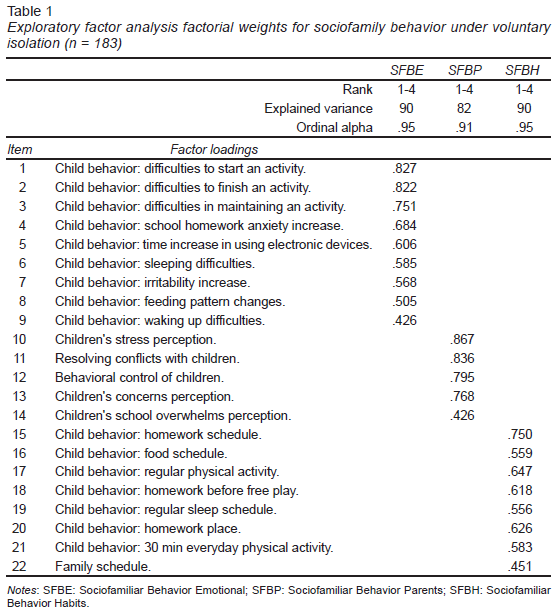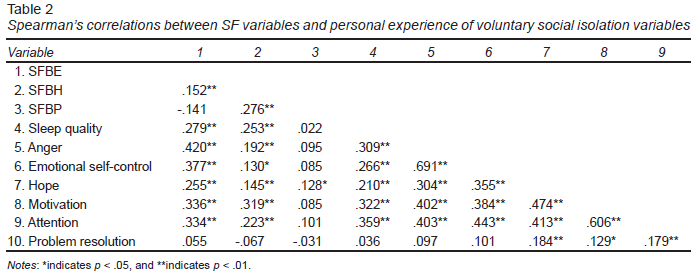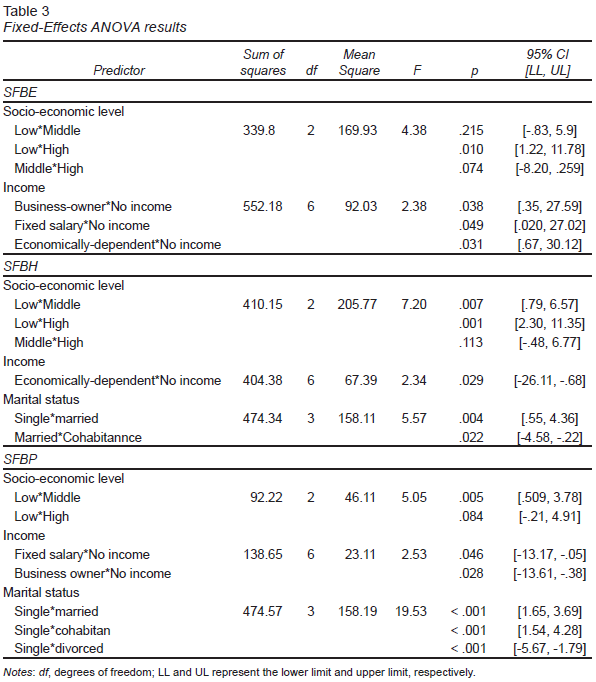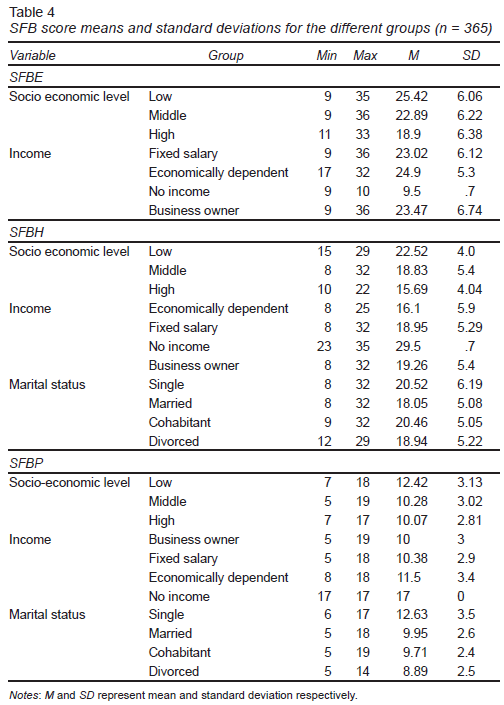Introduction
Global dispersion of the coronavirus type 2, which causes a severe acute respiratory syndrome (SARS-CoV-2), has led to worldwide measures being taken to prevent massive infections and reduce demands on healthcare systems. Two of the most important measures has been social distancing and the decree of voluntary social isolation at home (World Health Organization [WHO], 2020).
There are no precedents for a health related phenomenon of this magnitude and its psychological and economic impact that allows predicting the effects on human behavior, particularly on sociofamily behavior (SFB), including child-related connivance (CRC). Outbreak family clusters began to appear during 2019 presenting a series of respiratory symptoms (Luo, Xiong, Tang, & Zhou, 2020). Self-isolation can generate secondary uncertainty due to limited knowledge of COVID-19 and overexposure to related news that can cause or increase fear and anxiety reactions among the population. Furthermore, isolation by itself causes other well-known psychological effects, like boredom, frustration, and irritability (Li et al., 2020; Wang, Zhang, Zhao, Zhang, & Jiang, 2020a).
Wang et al. (2020b) reported the results of an online survey of 1304 people living in 194 cities in China with the aim of exploring the psychological consequences of social isolation as a preventive measure for the contagion of COVID-19. They found that around 26% of the people obtained scores on the scales that classified them within some level of depression, 36% scored with clinical levels of anxiety, and 32% with stress symptoms.
SFB is vulnerable to different intrapersonal and external factors, which directly influence its stability. The closure of schools and businesses as a preventive measure for contagion increases the experience of negative emotions, such as parents’ concerns about its impact on their children’s education and anxiety about childcare at home when they must continue to face economical sustainability (Brooks et al., 2020; Wang et al., 2020a).
Childhood, from birth to the onset of puberty, is a period in which significant physical, cognitive, social, and emotional changes occur. These changes depend both on genetic and environmental factors; within the latter, the family context has been pointed out as a relevant factor since it acts as a protective and introductory entity for the child to his/her cultural environment. Parents have an integral role in stimulating or inhibiting child development (Arranz et al., 2004). The relationship between factors such as socioeconomic status and parent-child interactions prove that family welfare is a highly sensitive system. It has been shown that parents’ conflict-solving abilities, educational, and socializing practices correlate with disruptive behavior in children (Fegert, Vitiello, Plener, & Clemens, 2020; Flouri, Narayanan, & Nærde, 2018; Lee, Kang, Cho, Kim, & Park, 2018; Luby et al., 2013; Masten & Osofsky, 2010). According to this evidence, adverse childhood events, such as natural or health-related disasters, war, confinement, poverty, and acute or chronic stress, can compromise infant neurodevelopment. Therefore, children are considered to be a vulnerable group during infectious disease outbreaks.
For example, those experienced in 2006 in India with the Chinkungunya outbreak and, in 2014, with the Ebola epidemic in West Africa. Given these scenarios, it became evident that the families’ economy was affected in a way that all members, including children, had limited access to medical care and food availability (Gopalan & Das, 2009). In these conditions, the families went through a period of uncertainty, in which feelings of sadness, anxiety, and frustration were exacerbated. All of these situations put the family at disadvantage due to the social and health impacts suffered by the main caregivers. In agreement with the Alliance for Child Protection in Humanitarian Action, Technical Note: Protection of Children during the Cornonavirus Pandemic (2019), a pandemic may result restructuring in family dynamics, since on several occasions, older siblings are the ones who provide basic diet and parenting care to younger children. Talking about young children specifically, they can present anguish about the disease, even if they do not understand its gravity, or the possible death of beloved ones. Also, they can show higher levels of stress due to the isolation of a relative in a healthcare center or mandatory confinement at home, since these measures grow fear by not clearly understanding what is happening.
The Alliance for Child Protection in Humanitarian Action (2019) has reported that certain factors such as family situation, irresponsible child care, and absence of family or community support can cause negative consequences on child development that may reflect stress and insufficient attention to basic needs. Following this line, the possible absence of parents due to illness or work, school burden, and daily responsibilities at home, can lead to emotionally intense environmental experiences (Svedin, 2008).
As previously mentioned, the current situation caused by the COVID-19 pandemic is affecting children and families in an exceptional way. Novelty stressors like homework, homeschooling, the closure of recreational centers, the absence of leisure activities, the constant fear for relative’s health and deaths, and the economic impact can generate a series of mental health-related problems such as stress, depression, and family violence (Fegert et al., 2020; Flouri et al., 2018; Vieira, Garcia, & Maciel, 2020).
Mental health risk factors associated with COVID-19 may disproportionately affect children in vulnerable conditions, so special attention should be given to these groups in order to prevent exacerbating previous disadvantages (Fegert et al., 2020).
According to all of the aforementioned, exploring people’s perception of changes in family behavior, including children’s, and the different social, economic, and personal characteristics during voluntary isolation will make possible, for health professionals, to identify primary care needs in vulnerable populations, and develop early interventions.
Due to the lack of instruments for measuring sociofamily behavioral changes during an outbreak derived self-isolation period and its effects on children’s behavior, the aim of this study is divided in three parts. First, to analyze the reliability of an ad-hoc designed questionnaire to measure some variables from this experience. Second, to characterize effects of voluntary social isolation in sociofamily behavior, at a personal level and over children’s activities at home. And third, to determine vulnerability predictors for a negative experience by isolation itself in a sample of parents of children from one to twelve years old under voluntary social isolation by COVID-19.
Method
Design of the study
This study proposes an observational transversal research design, with group comparison and correlation methods.
Participants
A sample of 365 participants was calculated using G*Power, with an alpha error probability of .05, a power (1 – β error probability) of .095 for estimations of proportion analysis. Only those who reported having children from one to 12 years old (n = 365) were included in the final sample. Respondents were parents who voluntarily agreed to participate and stated to be over 18 years old (mean 35.62 years, SD = 7.4). Exclusion criteria were to have missing data, to be younger than the requested age, being diagnosed with SARS-CoV-2, and therefore under mandatory confinement.
Measurements
An ad-hoc questionnaire was designed and submitted to reliability analysis. For the construction of this instrument, six experts in sociofamily behavior made dimension delimitations. In the first stage, five psychologists with expertise in child development, and one psychiatrist with expertise in family interactions participated. All of them had eight or more years of professional experience, and two of them had at least 10 years of experience in psychology research. To ensure content validity, each expert independently proposed a series of questions according to their area of expertise. At the second stage of the process, these questions were selected and theoretically grouped, similar to those found in literature from previously studied families under similar conditions, such as quarantine, confinement, or pandemic outbreak and its effects on children (Wang et al., 2020a) and sociofamily behavior were considered (Brooks et al., 2020; McKelvey et al., 2009; Valencia & Gómez, 2010; Zelman & Ferro, 2018). For the final part of the process, each expert suggested one or two items related to sociofamily behavioral changes during the afore mentioned conditions, and were all attached together in a unique questionnaire. The resulting instrument was submitted to a pilot sample of 35 adults from the same geographical area who were asked to answer it and comment about their experience with the instrument. A final version of 35 items was obtained, all related to perceived effects of self-isolation during the COVID-19 outbreak; in an ordinal measure level. Six items corresponded to personal effects; three were related to family effects; 22 were about perceived effects over children; and four, which were of nominal measure level, corresponded to children’s play description.
Procedure
The sample was recruited by an open invitation through social networks and emailed to the participants over a two-week period (April 21th to March 5th, 2020), suggesting them to also share the questionnaire to diversify and expand the sample. Respondents were instructed to answer only if they were under a situation of voluntary social isolation due to the COVID-19 outbreak. Finally, institutional mail was used to send the questionnaire to colleagues, students, and alumni of the universities involved in this research.
Data analysis
Results were analyzed as following: 1. Exploratory Factor Analysis (EFA) and Confirmatory Factor Analysis, for the 22 ordinal level items. 2. Descriptive analysis of children’s play behavior and Univariate Spearman’s correlations to determine the relation between the self-experience effect of the voluntary isolation, and the SFB perception of changes, and 3. ANOVA to compare variance between groups of socioeconomic level, income, and marital status, for the sum score of sociofamily behavior: emotional (SFBE), sociofamily behavior: habits, and sociofamily behavior: parents (SFBP), and descriptive statistics, means and standard deviations to present the observed significant differences. All statistical analyses were performed with SPSS 24, factor analysis (Ferrando & Lorenzo-Seva, 2016), and AMOS 24.
Ethical considerations
The Ethics Committee from the Faculty of Engineering and Business, Guadalupe Victoria from the Universidad Autónoma de Baja California, properly accepted the ethical considerations for the protocol of this study, registration number: POSG/020-1-01. All procedures of the study considered Helsinki’s statements and agreements. No personal identification data was asked in this study. Participants did not receive any compensation for their collaboration. Further demographic data is reported in the results section.
Results
Demographic data
The final sample consisted of 365 adults living in different regions of Mexico under conditions of voluntary social isolation due to the COVID-19 pandemic with an average of 30.9 days of isolation (SD 11.81). Of the participants, 76.9% were female (273) and 22.5% male (82), 2.7% (10) preferred to not answer. In relation to their marital status, 60.5% (221) were married, 20% (73) were single, 14.2% (52) lived in cohabitation, and 5.2% (19) were divorced. 310 (84.9%) reported living with their nuclear family, 15 (4.1%) only with their partner, 11 (3%) with second relatives, 7 (1.9%) lived alone, and 5 (1.4%) lived with other persons (friends, colleagues, roommates, etc.). The maximum number of children living with the same family was five, the mode was two (44.7%), and the answer options for ages were from one to 12 years old (mean 8.11, SD 5.2).
According to socioeconomic status, 90.7% (331) perceived themselves in a medium status, 5.8% (21) in a low status, and 3.6% (13) in a high status. 244 (66.8%) participants reported having stable and active jobs, and the remaining 121 (33.2%) were unemployed at the moment. The highest proportion of participants (221) stated that their main income source came from a fixed salary. Being more specific, 60.5%, 76 (20.8%) received their income from own business, 45 (12.3%) from mixed income, 2.7% (10) were financial dependents on others, nine (2.5) received variable income from service fees, .5% (2) received government financial support, and the remaining .5% (2) were surviving on savings and did not receive any other type of economic income.
Of the participants, 84.1% (307) reported having healthcare services, 45.5% (166) of them had private services, 20.5% (75) had public services, and the rest 24.9% (91), had both types of service. 264 (72.3%) of the participants answered that they agreed or strongly agreed with the measures of healthy distancing and voluntary isolation, while 8.8% (32) showed indifference and only .3% (1) stated they were in disagreement.
Reliability analysis for the Instrument of Sociofamily Changes Perception
A principal component analysis with orthogonal rotation was performed since the correlations between items were .2 to .5. The final instrument consisted of 22 items (n = 183), which met the proper ordinal measure level, and no missing data (Table 1). Bartlett’s sphericity test was significant (2001.3, DF = 231, p < .001) (KMO = .73, α = .81).
CFA was performed using a different sample (n = 182) than the one implemented for the EFA. The model of correlations for ordinal items showed significant correlations among dimensions and items (χ2 = 293.3, DF = 101, p < .001). Indices for structural equation model for the CFA were: goodness of fit index (GFI = .828), adjusted goodness fit index (AGFI = .769), residual mean root square index (RMR = .111), root mean square error of approximation (RMSEA = .103), comparative fit index (CFI = .783), and normed fit index (NFI = .708).
Changes in children’s play behavior
Parents were asked about the changes observed in their children’s play behavior during the voluntary social isolation. 21.7% perceived a greater presence of active games, 18.4% perceived an increase of participation in board games, 16.4% in video games, 11.7% in manipulative games with toys, 9.4% reported roleplay as predominant, 8.6% showed more frequency of creativity type of games, 8.2% different recreational activities, and 5.7% exploratory games. Regarding game themes, 49.5% of the parents mentioned that they observed a greater predominance of fantasy games, 19.5% of these games represented the current situation, 18.6% represented games of solidarity and other´s help, 10.5% an increase in violent games, 1.1% challenge/skill games and the remaining .8% stated that their children played mostly exploratory/educational games. In addition, parents reported that 35.6% of the children prefer to play with adults, 35.2% alone, and 28.9% with other children.
Factors associated with SFB negative experience of social isolation
Correlations showed that self-reported anger and emotional reactions were to be related with SFB negative changes perception among other significant correlations. Emotional SFB positively correlated with habits within the family environment; furthermore, emotional SFB significantly correlated with sleep quality, anger reactions, self of loosing emotional self-control, hopes about the future, motivation, and sense of loosing attention abilities. Besides, in general all difficulties effects perceived in SFB showed a positive correlation among the measured psychological features (Table 2).
We grouped socioeconomic status as three independent variables (low, middle, high) to analyze its effect over the three dimensions of sociofamily behavior perception (Emotional, Habits, and Parents skills). Levene’s tests showed homogeneity of variances for the groups, significant differences were found between socioeconomic levels groups in SFBH (F = 7.20, df = 2, p = .001) and SFBE (F = 4.38, df = 2, p = .013), and SFBP (F = 5.05, df = 2, p = .007). Marital status was divided into four groups: single, married, cohabitee, and divorced; this variable showed homogeneity of variance only for SFBH and SFBE; differences between groups of marital status for SFBH were significant (F = 5.57, df = 3, p = .001) and for SFBP (F = 19.53, df = 3, p < .001). Income groups were divided into stable-salary, business-owner, mixed-income, government-support, variable-honorary-income, economically dependent, and noincome. All of these three groups showed variance homogeneity. Significant differences were found in the between groups tests for SFBH (F = 2.34, df = 6, p = .031), and SFBE (F = 2.38, df = 6, p = .028), and SFBP (F = 2.53, df = 6, p = .020). For groups divided by income post-hoc tests showed differences only between stable salary (p = .049), business-owner, (p = .038), and economically dependent (p = .029) compared with noincome. Post-hoc with Bonferroni correction for the above groups and dimensions analysis is shown in Table 3. Descriptive statistics for groups and dimensions for the analyzed groups per dimension are presented in Table 4.
Discussion and conclusion
Behavioral factors could present variations in how different demographic and socioeconomic status groups face an outbreak and resolve upcoming psychological, healthrelated, economic and security problems, among others. This study presents a comparison of sociofamily behavior, including perception of changes, under voluntary social isolation due to the COVID-19 outbreak, among different demographic groups in Mexican population, and the reliability of the designed instrument to specifically measure sociofamily behavior changes perceived by parents during this isolation period. Although recent studies have shown some negative psychological effects of voluntary isolation by COVID-19, this is the first study focusing on sociofamily behavior in Mexican population that reports a correlation between sleep changes, anger and emotional reactions in sociofamily dimensions. This report explicitly emphasizes the effects of isolation and vulnerabilities in sociofamily behavior with a consequent increase in the global negative effects, specifically loss of motivation and hopes for the future, and more frequent anger reactions.
Play is a normal and expected behavior in childhood, so it can be highly sensitive to constant stress or traumatic events. Previous studies have reported changes in play patterns of children who were exposed to adverse events such as natural disasters, diseases, or war-related situations (Wolmer, Hamiel, Pardo-Aviv, & Laor, 2017; Stenman et al., 2019). In our study, parents reported a greater presence of active, fantasy-themed, pretend play focusing on the current situation, and a preference for playing with adults. It has been suggested that play can be seen as a psychological mechanism that allows processing and adaptive coping with stress. It is a way for emotional expression that facilitates organizing memories, integrating sensory experiences, and better understanding of situations. There are several neurobiological correlates of play, with better regulation of levels of alertness and fear (Cohen & Gadassi, 2018). Fantasy play allows children to take a more active role in a given situation; it is also noted that play involving the child parents contributes to resilience when faced with continuously stressful events (Cohen & Gadassi, 2018; Wolmer et al., 2017).
In previous studies, predictors of psychological impact had demonstrated contradictory evidence as to whether population’s characteristics and demographics could describe and predict the psychological impact of quarantine (Brooks et al., 2020). The results of this study support the idea that there is not a unique linear demographic feature that may anticipate sociofamily behavior changes for negative effects of the voluntary social isolation, but possibly a complex profile of features including, at least, some of those analyzed in this report: socioeconomic status, income source, and family composition.
It has been reported that health related disasters reaction of parents and children can reach traumatic levels due to the experience of stress responses during the disease containment (Sprang & Silman, 2013). While the response to health related disasters has been widely reported as a stress factor causing negative effects on people’s mental health (Maunder et al., 2008; Perrin, McCabe, Everly, & Links, 2009; Wong et al., 2008), this report concludes that there are specific family groups of higher vulnerability that may not be detected or attended during a pandemic disaster. These groups include low socioeconomic status individuals who particularly perceive greater negative changes and effects within sociofamily behavior, such as emotions, habits, home activities organization, and self-perception by parents. Low socioeconomic status has a statistical inverse relation with direct medical diseases contagion including neurological (Ghaffari-Rafi, Ghaffari-Rafi, & Leon-Rojas, 2020), respiratory (Cakmak, Hebbern, Cakmak, & Vanos, 2016; Reyes et al., 2018), and mood disorders (Chen et al., 2019). Data from this study suggests that socioeconomic status is also a predictor for personal or other possible family dysfunctional behaviors, including sleep patterns, homeschooling, and diet.
Marital status has also been considered a relevant factor for presenting a higher symptomatology of psychiatric disorders, including depression and anxiety, and there have been specific increases during the COVID-19 pandemic for divorced, separated or widowed (Tan et al., 2020). In this study, a particular effect was observed on sociofamily parental behavior for the families with children group, showing increased negative effects on their ability to solve conflicts between parents and children, behavioral control, and stress perception by the infants. The COVID-19 outbreak significantly degrades emotional well-being (Yang & Ma, 2020).
In the present study, the income source demonstrated to be a factor that significantly affects perception of changes in sociofamily behavior during voluntary isolation. This was particularly observed in the group of families who stopped working due to the outbreak, and therefore, stopped receiving economic income, with negative effects on habits and parental self-perceived abilities to solve child-related conflicts at home.
Once it is reported that psychiatric symptoms may be reduced if prevention measures are carefully taken when returning to normal activities (Tan et al., 2020), future studies should consider the sociofamily effects after returning to prior regular activities as protective measures taking into account family habits reorganization. This study highlights the importance to acknowledge the sociofamily changes caused by the voluntary social isolation during an outbreak as prolonged, as this in order to identify and prevent negative outcomes, and design proper interventions to solve or minimize consequent family conflicts. Undoubtedly, this unprecedented health related phenomenon is not only disrupting economic stability in most of the countries in the world, but also coexistence within households. The findings of this report also present a valid instrument to measure the perception of changes in sociofamily behavior that can be remotely administered and interpreted by mental health specialists.
The present investigation presents several strengths and limitations. Non-probabilistic convenience sampling permitted to gather information about the groups of interest (families under voluntary isolation with children from one to 12 years old), but leads to difficulties to generalize these findings to other groups of families with different ages, compositions, or by the number of children living with the same family. Further studies are also needed to describe the particular influence of anxiety and depression on the SFB.



